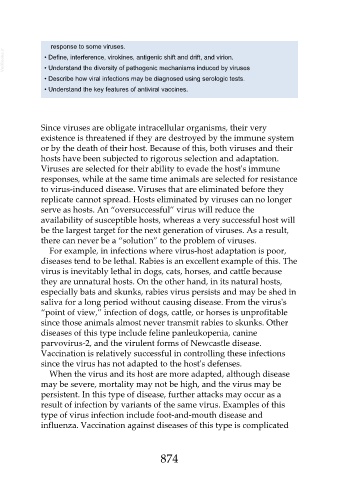Page 874 - Veterinary Immunology, 10th Edition
P. 874
response to some viruses.
VetBooks.ir • Define, interference, virokines, antigenic shift and drift, and virion.
• Understand the diversity of pathogenic mechanisms induced by viruses
• Describe how viral infections may be diagnosed using serologic tests.
• Understand the key features of antiviral vaccines.
Since viruses are obligate intracellular organisms, their very
existence is threatened if they are destroyed by the immune system
or by the death of their host. Because of this, both viruses and their
hosts have been subjected to rigorous selection and adaptation.
Viruses are selected for their ability to evade the host's immune
responses, while at the same time animals are selected for resistance
to virus-induced disease. Viruses that are eliminated before they
replicate cannot spread. Hosts eliminated by viruses can no longer
serve as hosts. An “oversuccessful” virus will reduce the
availability of susceptible hosts, whereas a very successful host will
be the largest target for the next generation of viruses. As a result,
there can never be a “solution” to the problem of viruses.
For example, in infections where virus-host adaptation is poor,
diseases tend to be lethal. Rabies is an excellent example of this. The
virus is inevitably lethal in dogs, cats, horses, and cattle because
they are unnatural hosts. On the other hand, in its natural hosts,
especially bats and skunks, rabies virus persists and may be shed in
saliva for a long period without causing disease. From the virus's
“point of view,” infection of dogs, cattle, or horses is unprofitable
since those animals almost never transmit rabies to skunks. Other
diseases of this type include feline panleukopenia, canine
parvovirus-2, and the virulent forms of Newcastle disease.
Vaccination is relatively successful in controlling these infections
since the virus has not adapted to the host's defenses.
When the virus and its host are more adapted, although disease
may be severe, mortality may not be high, and the virus may be
persistent. In this type of disease, further attacks may occur as a
result of infection by variants of the same virus. Examples of this
type of virus infection include foot-and-mouth disease and
influenza. Vaccination against diseases of this type is complicated
874

